As an Amazon Associate KitchenwareSets.com earns from qualifying purchases.
90s Kitchen Aesthetic 11 Simple Ideas You Need To Try
If you look around your kitchen and see a sea of honey oak cabinets, laminate countertops, and maybe even some shiny brass hardware, you might feel like you’re stuck in a time warp. For years, the quintessential 90s kitchen was the prime candidate for a complete gut renovation, a space many homeowners were desperate to escape. That specific shade of orange-toned wood became the symbol of a “dated” home, something to be covered up with layers of white paint as quickly as possible.
This feeling of having an outdated space can be frustrating, especially when you’re dreaming of a fresh, modern kitchen. You might be struggling with a layout that feels inefficient, finishes that look tired, and an overall aesthetic that doesn’t match the chic, contemporary styles you see on Pinterest and in design magazines. The thought of a full-scale remodel is overwhelming, leaving you wondering if there’s any hope for your 90s-era space without tearing it all down.
Here’s the good news: the 90s kitchen aesthetic is making a major comeback, and your kitchen is a potential goldmine of style. Updated for 2025, the trend now focuses on embracing those “good bones”—the functional layouts and quality wood—while refining them with modern touches. It’s all about celebrating natural wood tones, warm color palettes, and creating a space that feels both nostalgic and incredibly current.
@retro.avocado Here is my definitive ranking of the Top 10 kitchens our moms had in the 90s ✨ #90s #90smom #nostalgia
Feeling Stuck in a Time Warp? Here’s Why Your 90s Kitchen Is Actually a Goldmine
The 90s kitchen aesthetic, once defined by ubiquitous honey oak cabinets and practical laminate countertops, is experiencing a significant and stylish resurgence. Updated for 2025, this trend is no longer about dated finishes but has evolved to focus on the inherent warmth of natural wood tones, the brilliance of functional layouts, and the comfort of inviting color palettes, masterfully blending nostalgic charm with a sleek, modern finish. As a design strategist, I’ve seen countless homeowners despair over their 90s kitchens. But I’m here to show you the hidden potential and designer-approved secrets to making it shine.
The Great Comeback: What’s Old is New Again
The key 90s kitchen trends that are back in style for 2025 include natural wood cabinetry, large functional islands, warm color schemes like butter yellow, classic glass-front cabinets, and durable materials like butcher block and granite. Top interior designers are citing the longevity and practicality of 90s kitchen layouts as a major reason for their return. There’s a collective move away from the cold, sterile kitchens of the 2010s towards spaces that feel more personal, warm, and lived-in. The 90s aesthetic, at its core, was about creating a functional, comfortable heart of the home, a principle that is truly timeless.
Here are the key elements making a triumphant return:
- Natural Wood Cabinets: The star of the show, but this time without the orange sheen. Think light, natural tones of white oak and pine.
- Functional Kitchen Islands: The 90s popularized the island as a workspace. Today, they are larger, more versatile centerpieces for cooking, dining, and storage.
- Warm & Earthy Color Schemes: Pops of hunter green and soft butter yellow are replacing cool grays, creating an inviting and cheerful atmosphere.
- Durable, Natural Countertops: While laminate is out, the 90s also saw the rise of granite and butcher block, which remain popular for their durability and timeless appeal.
90s Kitchen Aesthetic: 11 Simple Ideas You Need To Try for a Modern Look
To get the modern 90s look, you can embrace natural wood tones, install a statement island, integrate appliances, upgrade countertops and backsplashes, refresh hardware, use warm paint, and add personal touches with textiles and curated displays. This isn’t about a museum-quality recreation; it’s about capturing the feeling of the 90s—warm, functional, and inviting—while using a contemporary design lens. The following ideas, curated from top design publications and successful real-world kitchen transformations, are not just concepts but actionable steps with visual inspiration to guide your refresh, ensuring a result that is both trendy and timeless.
1. Embrace Natural Wood (Without the Orange!)
The best way to update dated, orange-toned wood cabinets is to sand them down to their raw, natural state and seal them with a clear, water-based finish. This single change has the most dramatic impact, instantly modernizing the entire kitchen while celebrating the quality of the original wood. Forget layers of paint; the goal is to reveal the beautiful, light wood grain that’s been hiding underneath for decades. This approach works beautifully with oak, pine, or any solid wood cabinet.
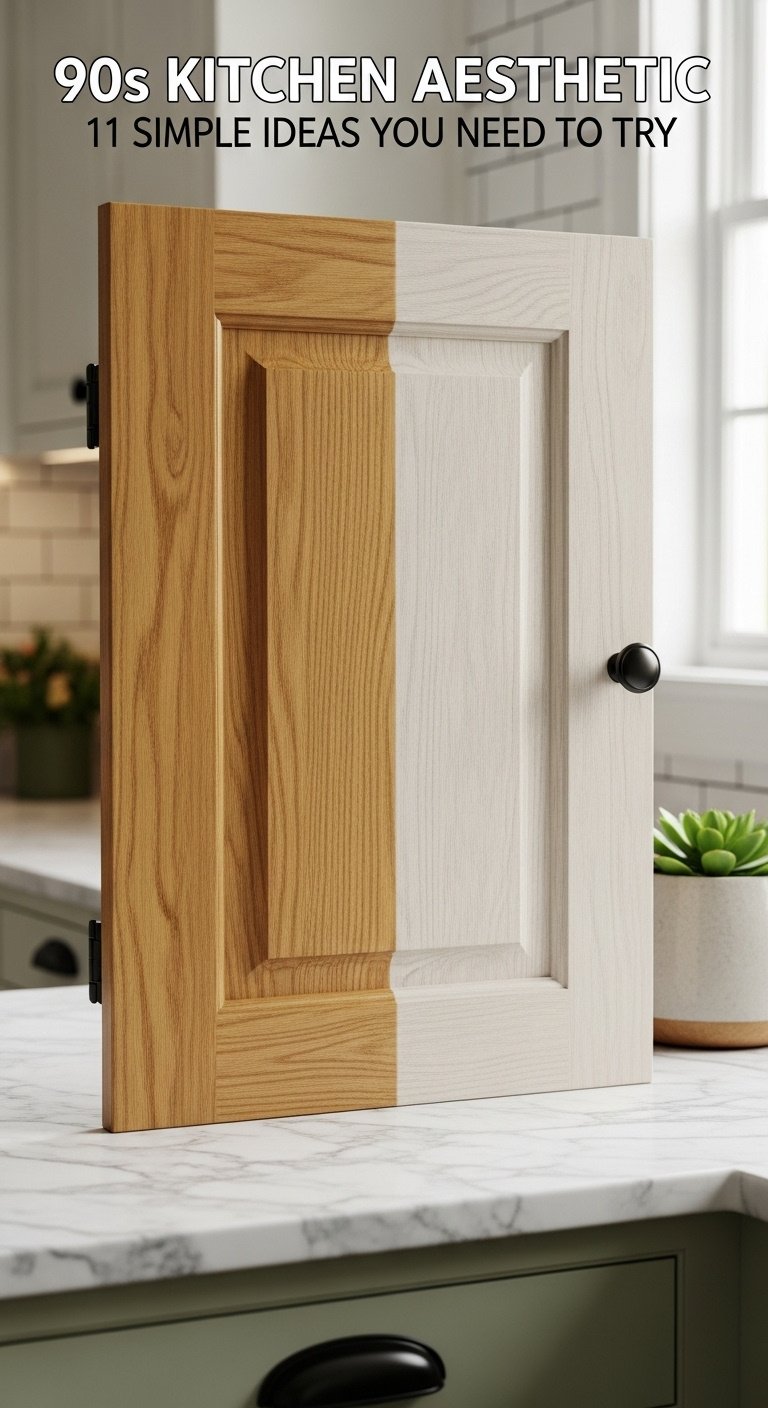
- Materials Needed: Orbital sander, various grit sandpapers (80, 120, 220), wood cleaner, tack cloth, wood conditioner (optional), clear water-based polyurethane in a matte or satin finish, quality paint brushes or foam rollers.
- Step-by-Step Directions:
- Prep: Remove all cabinet doors and hardware. Give all surfaces a thorough cleaning with a good wood cleaner to cut through any grease and grime from over the years.
- Sand: This is the most important step. Start sanding with a low-grit sandpaper (around 80-grit) to power through the old orange-toned finish. Once the old finish is gone, gradually move to a finer grit (120, then 220) to create a perfectly smooth, raw wood surface.
- Clean: Meticulously wipe away every speck of dust with a tack cloth. Any remaining dust will get trapped in your sealer.
- Seal: Apply a clear, water-based polyurethane sealer. Crucially, choose a matte or satin finish to maintain that natural, organic look. Avoid oil-based sealers, as they tend to yellow over time and will bring you right back to that 90s orange. Apply 2-3 thin coats, sanding very lightly with fine-grit sandpaper between each coat.
- Reassemble: Once the final coat is fully cured according to the manufacturer’s directions, re-install your beautiful doors with updated, minimalist hardware in black, brass, or chrome.
Pro-Tip: Before sealing all your hard work, test your polyurethane on a hidden spot, like the back of a drawer front. This is a crucial step to ensure you love the final color. Some woods can slightly darken or change tone when sealed, and it’s better to know that before you’ve coated the entire kitchen.
Pin this before-and-after idea for your cabinet glow-up!
2. Make the Island the Star
To make your kitchen island a modern centerpiece, focus on enhancing its functionality and turning it into a visual focal point with a contrasting color or upgraded countertop material. The 90s introduced the island as a workhorse, but today’s islands are the social hub of the kitchen. Making it larger, adding seating, or simply giving it a bold new identity can redefine the entire space.
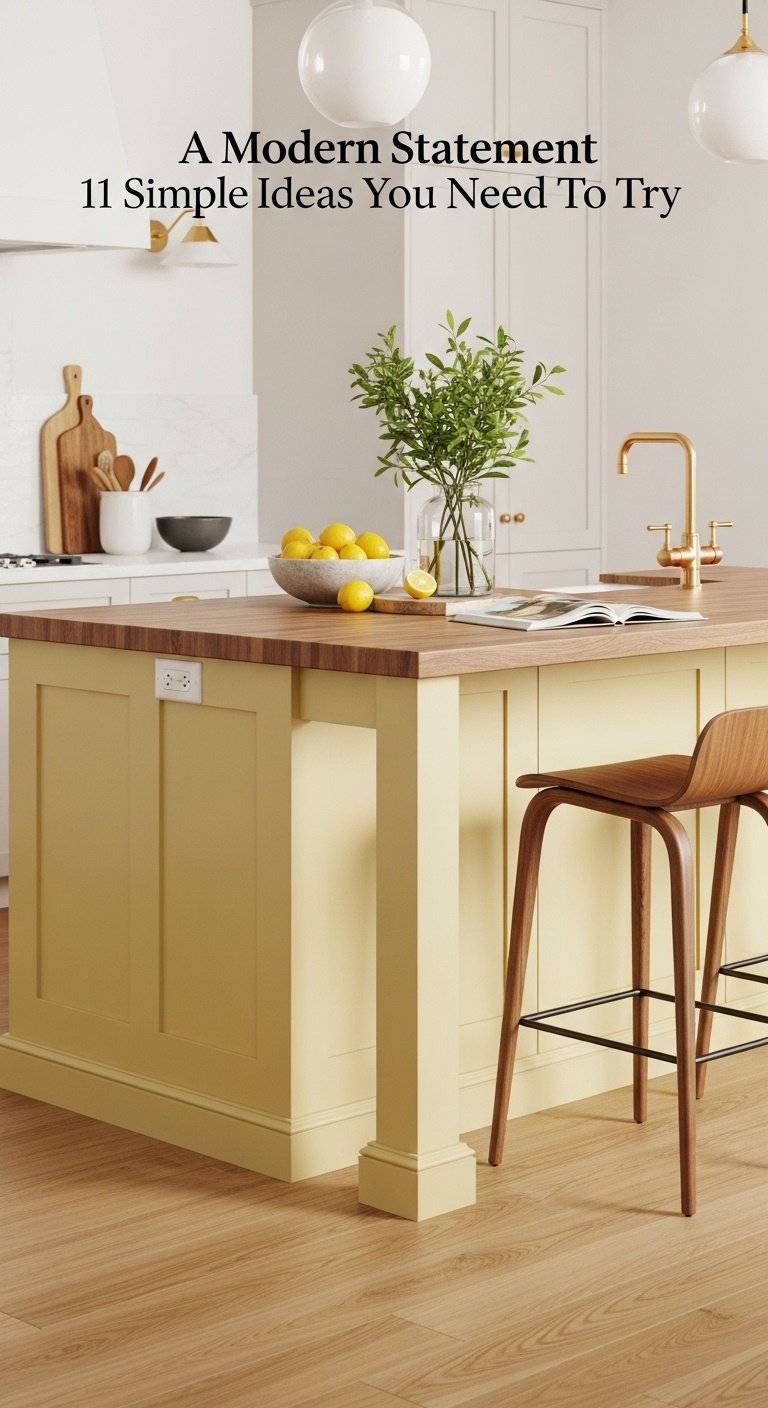
- Materials Needed: A pre-fabricated kitchen island or rolling cart, paint or stain (optional), new countertop material (e.g., a pre-cut butcher block slab), construction adhesive, drill, screws, new hardware.
- Step-by-Step Directions:
- Assess: Measure your space carefully. To ensure good flow, you should aim for at least three feet of clearance between the island and your perimeter countertops.
- Choose: Select your island. If you have the space, a larger, permanent island is fantastic. For smaller kitchens or renters, a rolling cart or a repurposed vintage dresser can provide flexible prep space and storage.
- Customize: Make it stand out. Paint or stain the base of the island in a color that complements your main cabinets. A deep sage green, soft butter yellow, or classic navy blue can make it a true statement piece.
- Top It Off: Upgrade the countertop. A thick slab of butcher block adds instant warmth and is a direct nod to the 90s aesthetic. You can have a slab cut to size at a home improvement store and secure it with construction adhesive and screws from underneath.
- Add Function: Think about how you’ll use it. Install hooks on the side for tea towels, add a paper towel holder, or update the pulls to coordinate with your main cabinetry.
Lesson Learned: From my experience in redesigning kitchens, I’ve learned you should not just think about size; think about purpose. If you’re constantly running out of prep space, prioritize a large, clear countertop surface. If you’re desperate for storage, look for an island with deep drawers or open shelving for baskets.
Save this island inspiration to your “Dream Kitchen” board on Pinterest!
3. Integrate Your Appliances
You can achieve a sophisticated, streamlined kitchen by using panel-ready appliances that blend seamlessly with your cabinetry or by choosing modern finishes like matte stainless steel. This concept, which started with built-in microwaves in the 90s, has evolved into a high-end look where refrigerators and dishwashers can completely disappear, creating an uninterrupted wall of beautiful cabinetry.
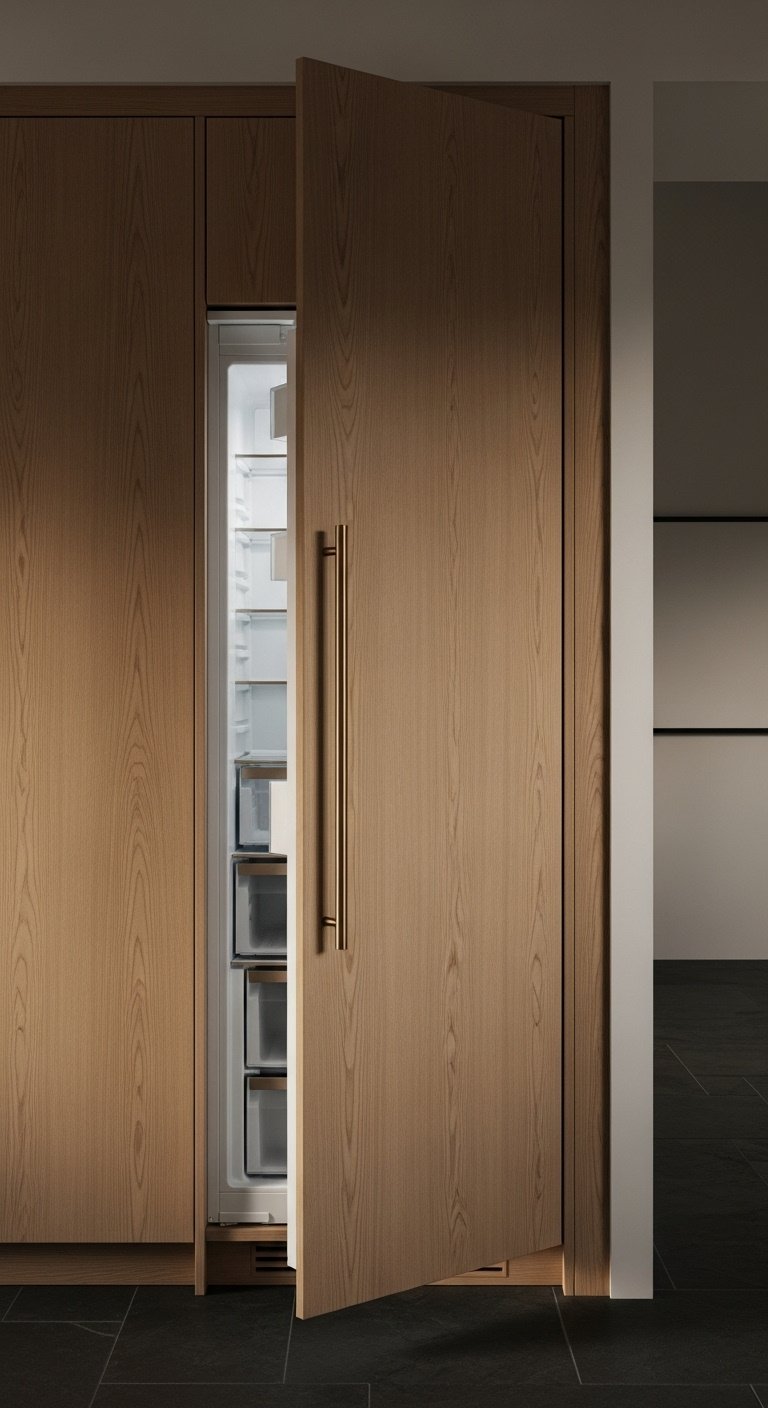
- Materials Needed: Appliance paint kit (for updating color), cabinet panels (for integrated look), professional installer (recommended for panel-ready appliances), recessed microwave shelf.
- Step-by-Step Directions:
- The Budget Hack: If brand new appliances aren’t in the budget, you can still modernize. Use a specialized appliance paint kit to transform a dated white or black appliance into a chic stainless steel or matte black finish.
- The Built-In Trick: Get your microwave off the counter. A common 90s feature was the over-the-range microwave, but a more modern look is to remove a smaller upper cabinet and install a built-in shelf for your microwave, creating a custom, recessed look.
- The High-End Upgrade: When it’s time for a major appliance replacement, invest in “panel-ready” or “integrated” models. These refrigerators and dishwashers are designed to have custom cabinet fronts attached, allowing them to vanish into your kitchen’s design.
- Hardware Harmony: Pay attention to the details. If your appliances have visible handles, ensure they coordinate with your cabinet hardware for a thoughtful, cohesive appearance.
Pro-Tip: Integrating appliances, especially panel-ready models, can be a complex task. I always recommend hiring a professional installer. They will ensure a perfect, flush fit and, most importantly, proper ventilation, which is absolutely crucial for the longevity and safe operation of your expensive new appliances.
Love this sleek look? Share it with a friend who’s renovating!
4. Ditch Laminate for Modern Countertops
Explore modern, durable, and stylish alternatives like quartz, granite, or butcher block to replace dated 90s laminate countertops. While the brown tones and faux granite of the 90s are best left behind, the era also introduced enduring materials that work beautifully today. An upgrade to a quality countertop material instantly elevates the entire kitchen.
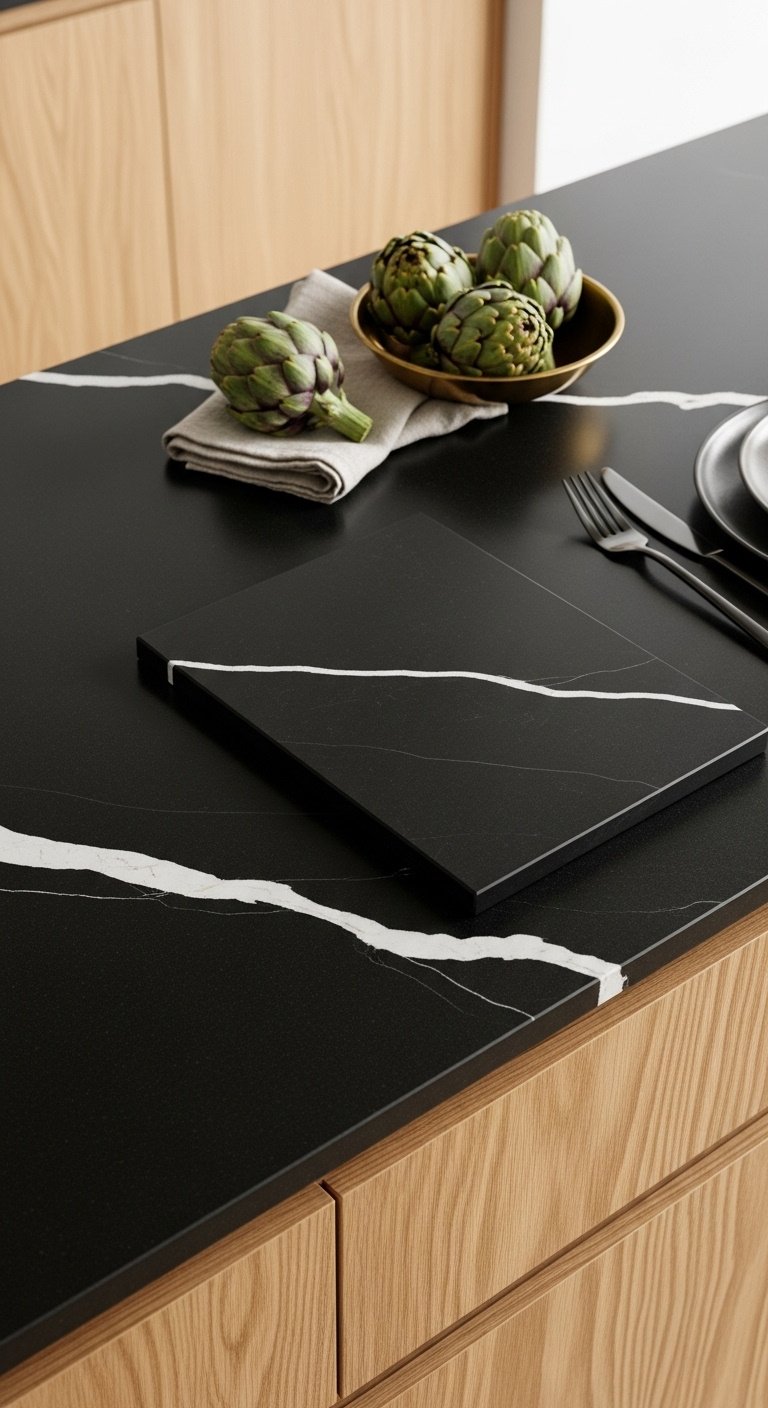
- Materials Needed: Countertop material of choice (Quartz, Granite, Butcher Block), measuring tape, silicone caulk, level. (Note: Professional installation is highly recommended for stone).
- Step-by-Step Directions:
- Measure Up: Before you do anything, carefully measure your existing countertops. Draw a simple diagram with dimensions to get an accurate square footage. This is the number you’ll need for getting quotes.
- Select Your Style: Consider the overall look. For a sophisticated, high-contrast look with warm wood cabinets, a black or white quartz is a stunning choice. For maximum warmth and a direct nod to the 90s country aesthetic, consider butcher block, which is especially beautiful on an island.
- Get Quotes: Installing stone countertops is not a typical DIY job. Contact at least three local fabricators to get quotes for materials and installation. They will handle the templating, cutting, and professional installation.
- The DIY Alternative: If a full replacement isn’t feasible right now, you can get a temporary fix. High-quality countertop paint kits or heavy-duty, peel-and-stick contact paper designed for countertops can cover old laminate for a surprisingly effective refresh.
Pro-Tip: When you’re looking at quartz or granite slabs, ask your fabricator about a “honed” or “matte” finish instead of the standard polished one. It’s a much more contemporary and high-end look that does a better job of hiding fingerprints and gives the stone a softer, more organic feel.
What countertop would you choose? Pin your favorite look!
5. Install a Timeless Backsplash
You can easily update a dated kitchen by replacing an old 4×4 diagonal tile or non-existent backsplash with a classic, stylish option like subway tile. A new backsplash is a relatively low-cost project that makes a huge visual impact, cleaning up the space between your countertops and cabinets and adding a layer of texture and personality.
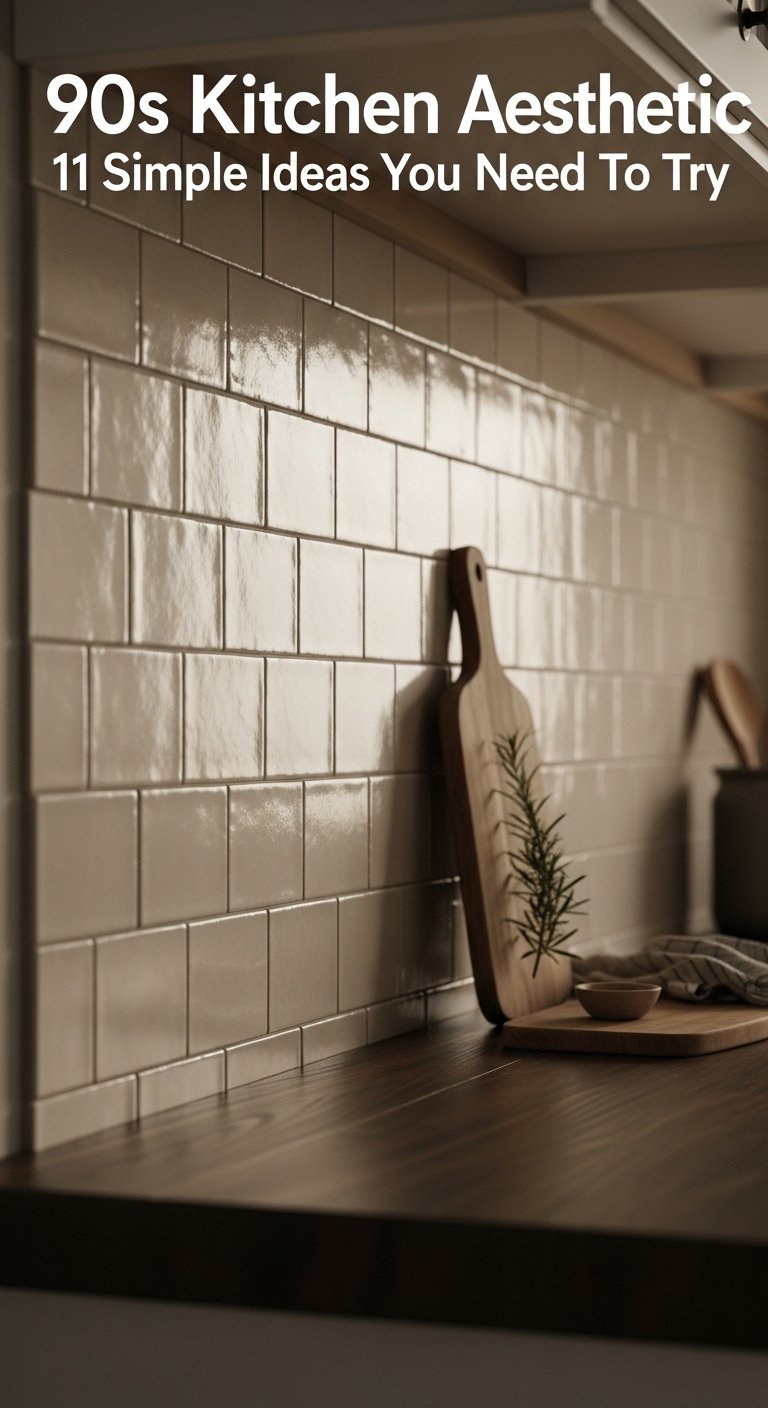
- Materials Needed: Tiles of choice, thin-set mortar, notched trowel, tile spacers, tile saw or cutter, grout, grout float, sponge.
- Step-by-Step Directions:
- Prep the Wall: Start with a clean slate. Your wall needs to be clean, completely dry, and flat. If you have an old backsplash, carefully remove it and patch any damage to the drywall.
- Apply Mortar: Use the notched trowel to spread a thin, even layer of thin-set mortar on a small section of the wall (about 2-3 square feet at a time).
- Set Tiles: Firmly press the first tile into the mortar with a slight twist to set it. Use tile spacers to ensure you have perfectly even gaps for your grout lines. Continue setting tiles, cutting them as needed with a tile saw to fit around outlets and at the end of rows.
- Let it Cure: Patience is key. Allow the mortar to dry completely according to the manufacturer’s instructions, which is typically 24 hours. Don’t rush this step.
- Grout: Remove all the spacers. Use a grout float to apply grout over the tiles, pressing it into the gaps at a 45-degree angle. After a few minutes, use a large, damp sponge to wipe the excess grout off the faces of the tiles.
Pro-Tip: For a modern take on the 90s 4×4 tile, look for a tile with a slightly uneven, handmade texture, often called Zellige. The key is to lay it in a straight “stacked” grid pattern instead of the traditional diagonal or offset layout. Pair this with a very thin grout line for a chic, minimalist look.
Save this timeless backsplash idea to your ‘Kitchen Reno’ board!
6. Add Personality with Patterned Textiles
You can easily add charm, color, and nostalgic warmth to your kitchen by incorporating patterned textiles like gingham curtains, striped tea towels, or floral cushions. This is one of the easiest and most affordable ways to inject personality into your space. It’s a key feature of the “Nancy Meyers aesthetic,” which embodies that cozy, lived-in, and effortlessly chic 90s vibe.
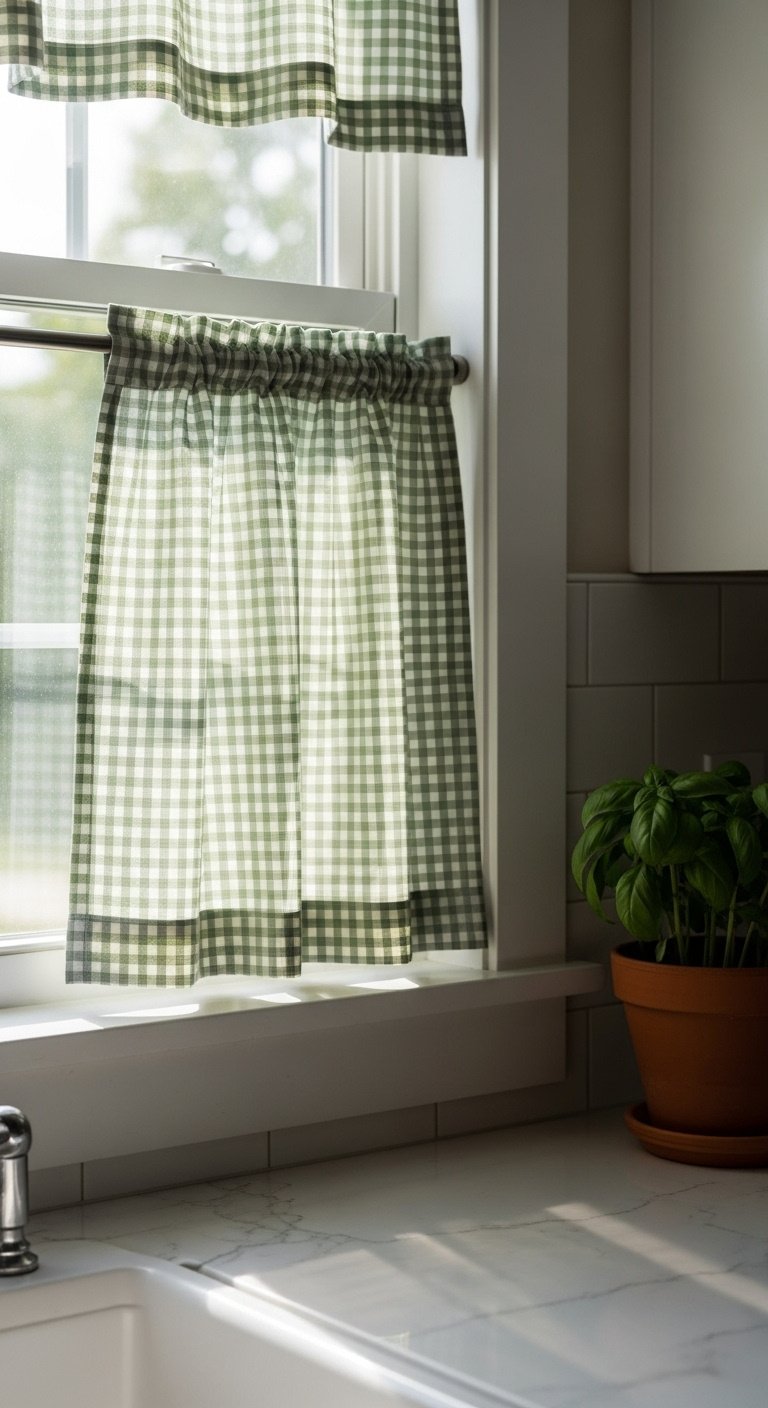
- Materials Needed: Fabric of choice (gingham, striped, or floral cotton/linen), sewing machine or iron-on hem tape, tension rod for cafe curtain, fabric for placemats or napkins.
- Step-by-Step Directions:
- Cafe Curtains: Measure the lower half of your kitchen window. Cut your fabric to size, leaving a 2-inch allowance on all sides for hems. Fold and press the edges, then either sew or use iron-on hem tape to create clean, crisp hems. Create a pocket at the top that’s wide enough for your tension rod to slide through.
- No-Sew Napkins: Cut 18×18 inch squares of your chosen fabric. Use iron-on hem tape on all four sides to create a quick, polished set of custom napkins that perfectly match your decor.
- Instant Charm: The simplest trick of all: simply drape a classic striped or gingham tea towel over your oven handle or by the sink. It’s an instant pop of pattern and color.
- Cushioned Comfort: If you have an eat-in kitchen with a bench or wooden chairs, find or make simple cushions in a charming floral print to add softness and style.
Lesson Learned: The key to using pattern successfully is restraint. Don’t overdo it. I always advise my clients to pick one or two patterns to feature. For instance, if you choose beautiful gingham curtains, stick to solid-colored or simple striped towels. This keeps the look feeling curated and charming rather than visually cluttered.
Adding a touch of pattern is so easy! Pin this for later.
7. Go Warm with Your Color Palette
To create a warm and inviting atmosphere, choose paint colors in shades of butter yellow, warm off-white, mushroom, or sage green. The 90s were known for their earthy and warm color schemes, a welcome departure from the cool grays that dominated the last decade. Painting your walls or even your cabinets in one of these welcoming hues is a powerful way to set a nostalgic and cozy tone.
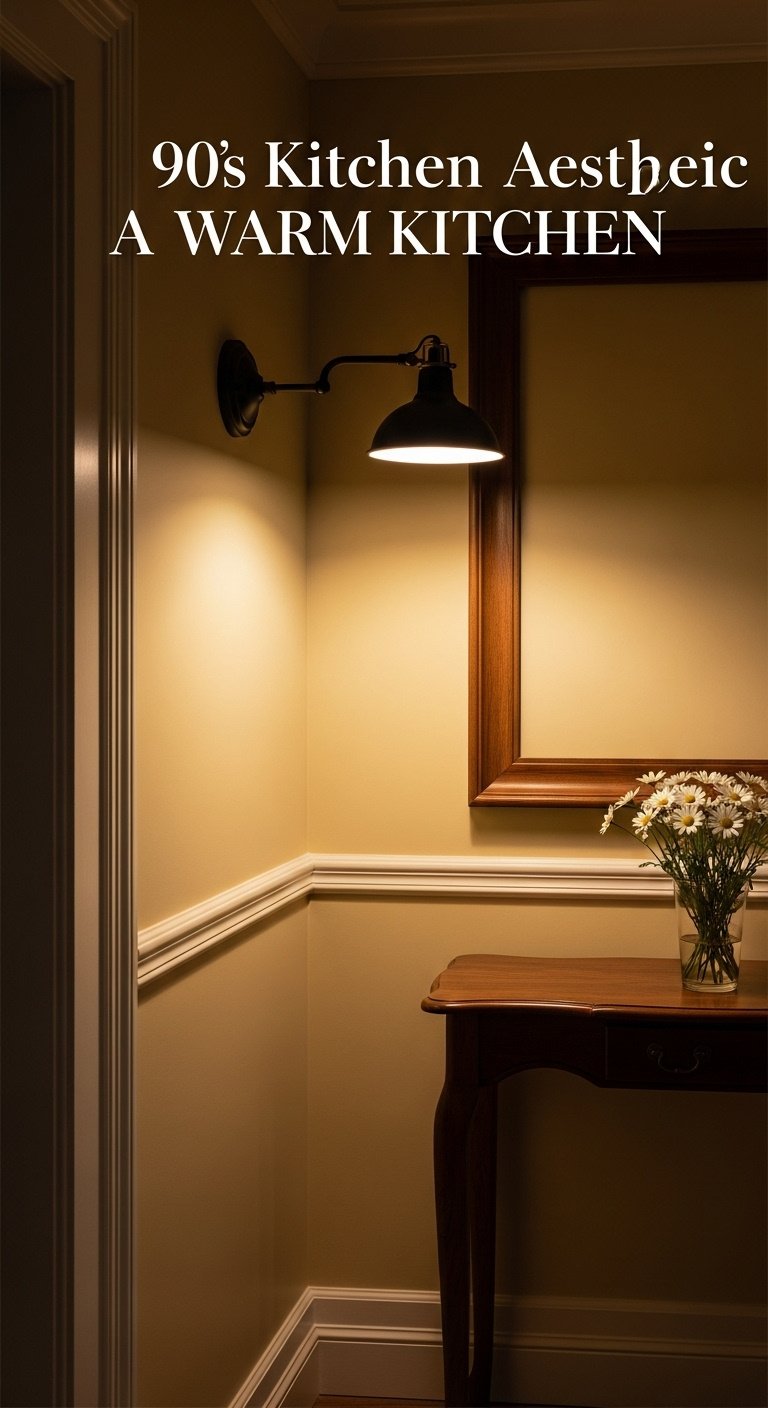
- Materials Needed: High-quality interior paint (e.g., butter yellow, mushroom, or warm white), paint roller and tray, angled paintbrush for cutting in, painter’s tape, drop cloths, TSP or cleaner.
- Step-by-Step Directions:
- Choose Your Vibe: Select a warm color that speaks to you. For a cheerful and very on-trend look, go with a soft butter yellow. For a more neutral, sophisticated, and earthy feel, choose a mushroom, biscuit, or warm off-white.
- Prep is Key: This is 90% of the work for a professional-looking job. Clear the room as much as possible. Cover floors and any remaining items with drop cloths. Use painter’s tape to get clean lines around trim, ceilings, and outlets. Finally, clean your walls with a degreasing cleaner to ensure the paint adheres properly.
- Cut In: Use the angled brush to paint a 2-3 inch border along the edges of the ceiling, trim, and in the corners where a roller can’t reach.
- Roll the Walls: Pour paint into your tray. Load your roller and apply the paint to the main wall surfaces, working in a “W” or “N” pattern to ensure even coverage without roller marks.
- Apply Second Coat: Wait for the first coat to dry completely (check the can for recoat times) before applying a second coat. This is essential for achieving a rich, even, and durable color.
Pro-Tip: I cannot stress this enough: always test paint samples on your actual walls before committing. A color you love at the store will look completely different depending on your kitchen’s unique natural and artificial lighting. Paint a large swatch (at least 1×1 foot) on the wall and observe it at different times of the day and night.
What warm color would you paint your kitchen? Let us know in the comments!
8. Style with Curated Glass-Front Cabinets
You can break up the visual weight of solid wood cabinetry and display your favorite items by using glass-front cabinets for a curated, stylish look. Glass-front or “display” cabinets were popular in the 90s, and they’re back in a big way. The modern approach is less about cluttered storage and more about creating a styled moment that adds personality and lightness to the kitchen.
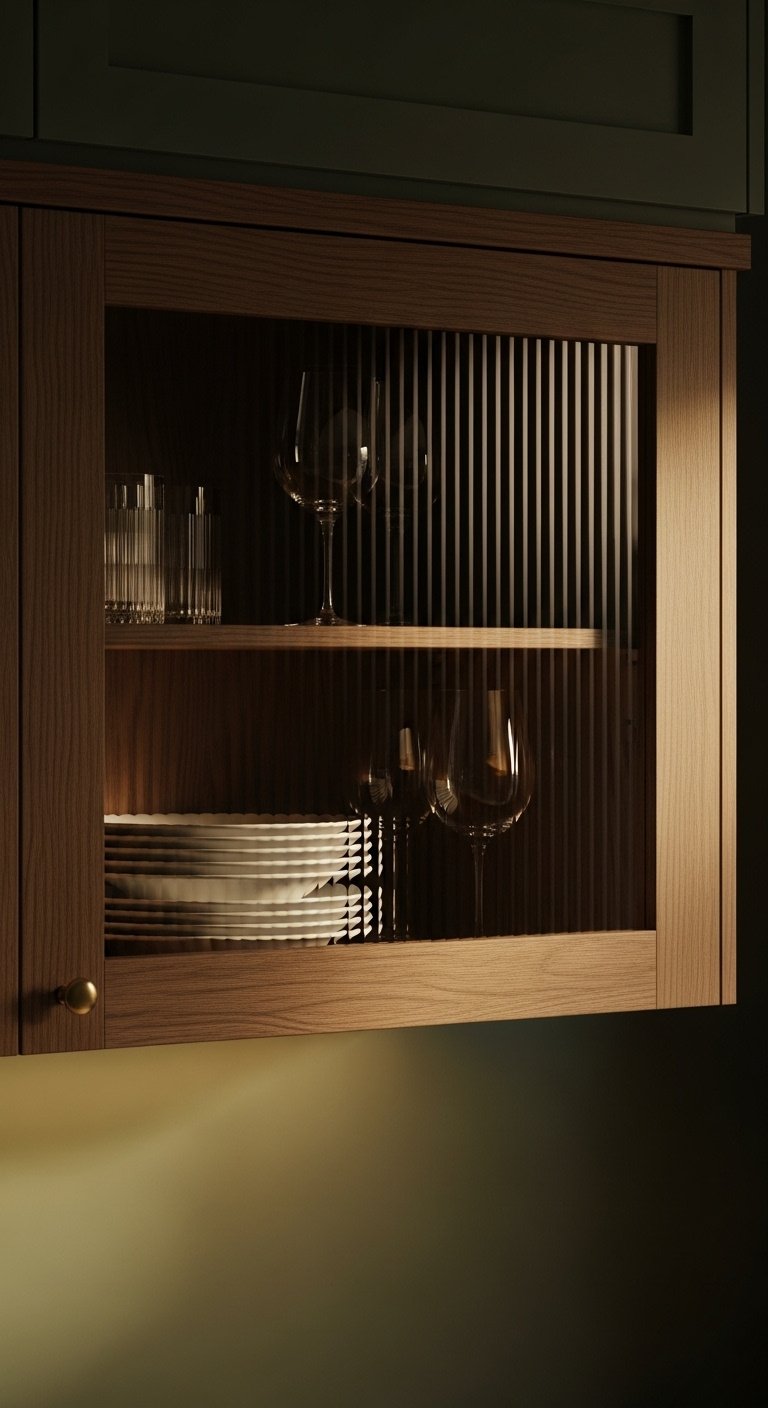
- Materials Needed: Router (for DIY), pre-made glass-front cabinet doors, or a kit to add glass to existing doors. For styling: curated dishes, glassware, cookbooks.
- Step-by-Step Directions:
- The Easy Swap: The simplest and most foolproof method is to order new, pre-made glass-front doors that are specifically sized to fit your existing cabinet boxes. You can then simply swap them out.
- The DIY Method: If you’re handy, you can convert an existing solid door. Carefully remove the center panel of the door. Use a router to create a small lip (a rabbet) on the inside of the door frame for the glass to sit in. Have a piece of glass cut to size and secure it with clear silicone or small glazing points.
- Styling is Everything: This is the fun part! Don’t just cram things in. Create a curated display. A great strategy is to stick to a simple color scheme, like all white ceramic dishes or a collection of clear glassware. Stack items neatly, vary the heights, and add a small piece of art, a vintage cookbook, or a trailing plant for interest.
Lesson Learned: If the thought of keeping your cabinets perfectly styled at all times gives you anxiety, opt for reeded or frosted glass. From my own projects, I’ve found this is the perfect compromise. It provides the lightness and textural interest of a glass door while subtly obscuring the contents, giving you the high-end look without the pressure of perfect, constant organization.
Pin this chic storage solution for your kitchen!
9. Refresh Hardware & Lighting
One of the easiest and most affordable ways to update your kitchen is by swapping out dated hardware and lighting fixtures for modern-yet-classic options. This small change has an outsized impact on the overall feel of the room. Moving on from the shiny, rounded brass knobs and fluorescent light clouds of the 90s to more streamlined hardware and statement lighting can instantly bring your kitchen into 2025.
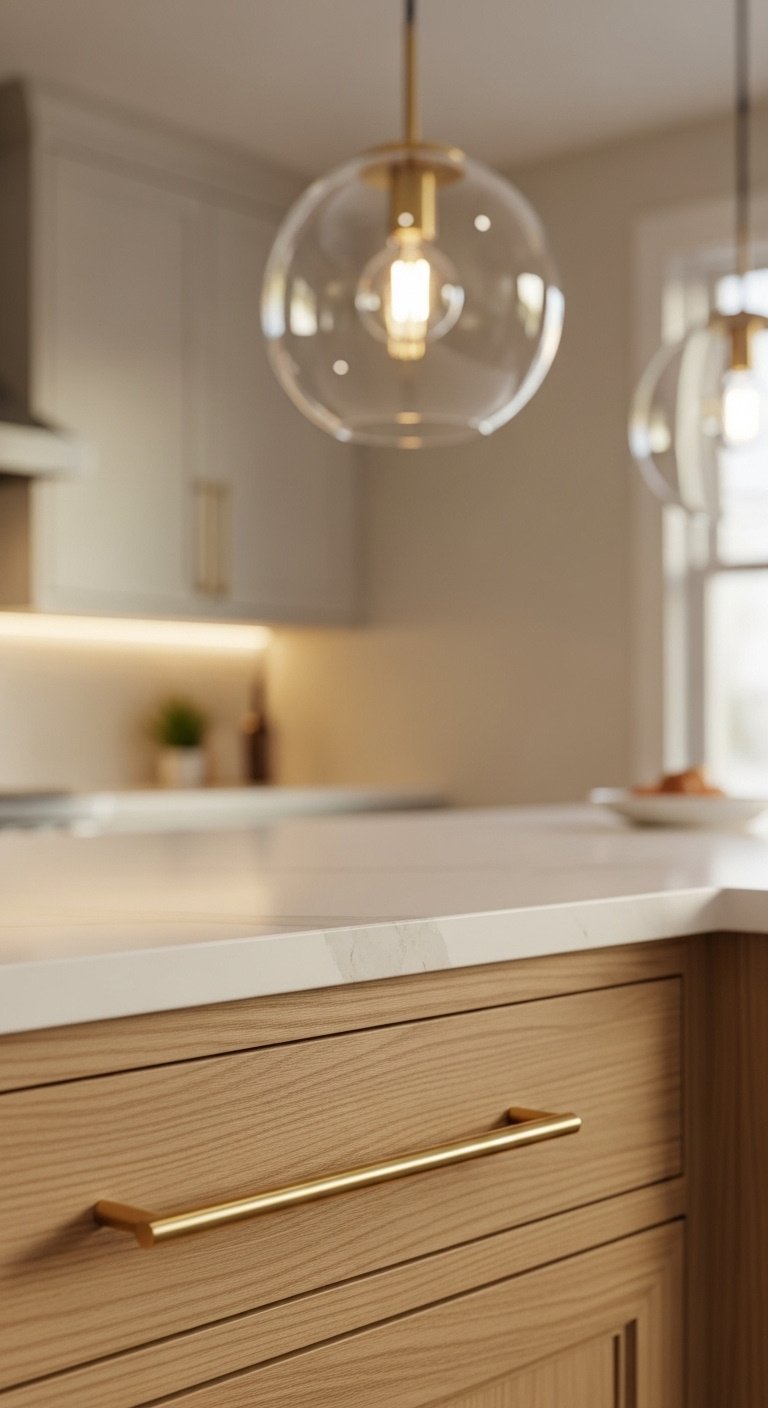
- Materials Needed: New cabinet knobs/pulls, screwdriver, new light fixture, wire stripper, voltage tester, wire nuts. (Consult an electrician for lighting if unsure).
- Step-by-Step Directions:
- Hardware Swap: This is a fantastic beginner DIY project. Simply use a screwdriver to remove the screw from the inside of the cabinet door or drawer, take off the old hardware, and screw in the new piece. It’s that easy.
- Lighting Update (Safety First!): Begin by turning off the power to the light fixture at the circuit breaker. Always use a voltage tester on the wires to confirm there is no power before you touch anything.
- Remove Old Fixture: Unscrew the canopy of the old fixture to expose the mounting bracket and wiring. Carefully unscrew the wire nuts to disconnect the wires.
- Install New Fixture: Following your new fixture’s instructions, connect the wires (usually black to black, white to white, and the bare copper wire to the grounding screw). Secure the connections with wire nuts. Attach the new fixture to the electrical box.
- Restore Power: Turn the circuit breaker back on and flip the switch to test your beautiful new light.
Pro-Tip: Don’t be afraid to mix metals, but the key is to do it thoughtfully. A great rule of thumb I use is to choose one dominant metal and one or two accent metals. For example, if you have stainless steel appliances, you can absolutely use warm brass for your cabinet hardware and a matte black pendant light. The key is to make it look intentional and balanced.
An easy update with a big impact! Save this idea now.
10. Bring Back the Pot Rack
Add nostalgic character and highly functional storage to your kitchen by installing a hanging pot rack. This is a quintessential element of the cozy, “Nancy Meyers” kitchen aesthetic. It not only frees up valuable cabinet space but also turns your beautiful cookware—like copper pots or cast iron pans—into a stunning decorative display.
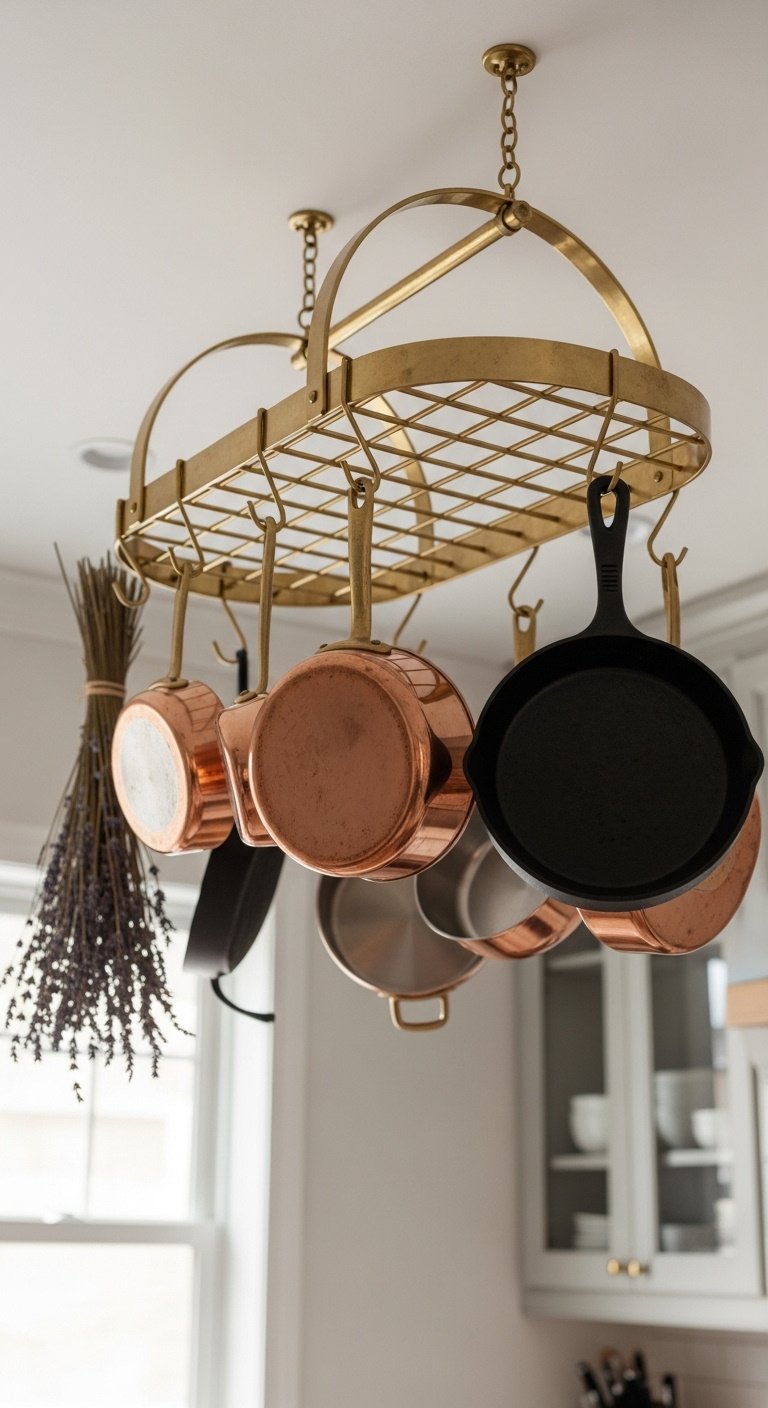
- Materials Needed: Pot rack kit, heavy-duty ceiling hooks or wall anchors, drill, stud finder, level.
- Step-by-Step Directions:
- Location, Location: Choose the perfect spot for your rack. This is typically over a kitchen island or a peninsula. Make sure you hang it high enough so that no one will bump their head on the hanging pots.
- Find the Studs: This is the most critical step for safety. Use a stud finder to locate the solid wood ceiling joists or wall studs. A pot rack loaded with heavy cookware must be anchored into solid wood, not just drywall.
- Mark and Drill: Use a level to ensure your anchor points are perfectly aligned. Mark your spots and drill pilot holes for the heavy-duty hooks that came with your kit.
- Install the Rack: Screw the hooks securely into the pilot holes in the joists. Hang the pot rack from the hooks.
- Display Your Cookware: Now for the fun part. Hang your most attractive pots and pans. You can also mix in other items like a colander, a string of garlic, or a bundle of dried herbs for that true country-chic vibe.
Lesson Learned: Remember that a pot rack is also a decluttering tool, not an excuse for more clutter. I always tell people to only hang the pots and pans they use regularly and truly love. An overstuffed, chaotic pot rack can make a kitchen feel smaller and more stressful, which is the opposite of what we’re trying to achieve.
Ready to add some character? Pin this functional decor idea!
11. Create a Functional Nook
Reduce clutter and improve your kitchen’s workflow by creating a dedicated, functional zone like a coffee bar or breakfast station. Many 90s kitchens have an underutilized corner or a small desk area that can be repurposed into a highly functional and stylish nook. This helps to get small appliances off your main countertops and corrals related items in one organized spot.
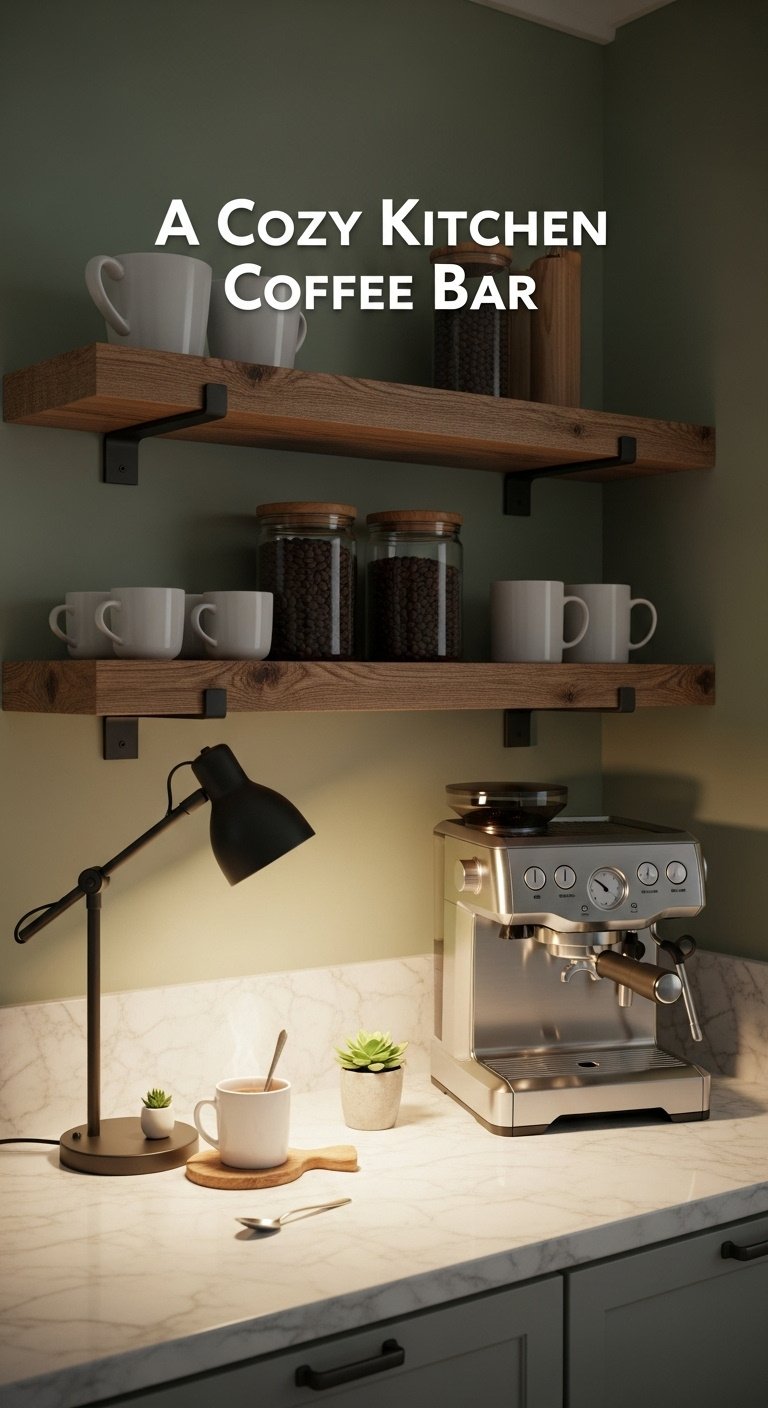
- Materials Needed: A small section of countertop, floating shelves, brackets, drill, level, decorative storage containers.
- Step-by-Step Directions:
- Identify a Space: Look for an underutilized corner, a small stretch of wall between a door and a cabinet, or that classic 90s kitchen desk that you never actually use.
- Create a Surface: If there isn’t one already, install a small piece of butcher block or have a remnant of quartz cut to size to create a dedicated countertop for your station.
- Go Vertical: Install two or three floating shelves on the wall above the countertop. This is where you’ll store mugs, coffee canisters, glasses, or bowls for your station.
- Organize and Style: Use attractive containers to store coffee beans, tea bags, or smoothie ingredients. Add a small tray to ground the items on the counter and make the space feel intentional. Plug in your coffee maker or blender.
- Add a Task Light: For a final touch, install a small, battery-operated LED puck light under the lowest shelf to illuminate the space and make it feel like a custom feature.
Pro-Tip: Think beyond just coffee! This concept works wonderfully for all kinds of dedicated stations. I’ve designed a smoothie bar with a blender and jars of protein powder and seeds, a baking nook with beautiful canisters of flour and sugar, and even a “tech hub” or charging station to finally get all the phones, tablets, and cords off the main kitchen counter.
Who needs this coffee bar in their life? Save this idea!
Key Takeaways: Your Quick Guide to the 90s Kitchen Aesthetic
- Don’t Fear Wood: Instead of reaching for paint to cover up 90s oak, try sanding it down to its natural, lighter tone for a fresh, 2025 look that celebrates quality craftsmanship.
- Warmth is Welcome: Swap out cool grays for inviting warm whites, soft butter yellows, and earthy greens to capture the cozy, welcoming essence of the era.
- Function First: Embrace the best parts of 90s kitchen design, like large, hardworking islands and open-concept layouts, which are still highly desirable and functional in today’s homes.
- Upgrade Surfaces: The biggest visual impact often comes from replacing dated laminate countertops and 4×4 tile backsplashes with modern classics like quartz, butcher block, or subway tile.
- Details Matter: Never underestimate the power of small changes. Updating cabinet hardware, installing a new light fixture, and incorporating patterned textiles can completely transform your space on a budget.
People Also Ask About 90s kitchen aesthetic
What did a 90s kitchen look like?
A typical 90s kitchen featured warm honey or golden oak cabinets, often with arched tops. Countertops were commonly laminate, sometimes in faux granite patterns, or the real granite in shades like Butterfly Green or Baltic Brown. Many kitchens had a 4×4 tile backsplash (often laid diagonally), a central kitchen island, and shiny brass hardware.
Are 90s kitchens coming back in style?
Yes, many core elements of 90s kitchens are back in style for 2025, but they are being reinterpreted with a modern twist. Designers are enthusiastically embracing the warmth of wood cabinets (but in natural, lighter tones, not orange), the practicality of functional layouts with large islands, and cozy, earthy color palettes. The focus is on blending the era’s comfortable and functional aspects with sleek, contemporary finishes.
What is the 3×4 kitchen rule?
The 3×4 kitchen rule is a classic design guideline for creating a functional and comfortable kitchen layout. It suggests maintaining at least three feet of space for walkways between countertops and a more generous four feet of space between the major work zones—typically the sink, stove, and refrigerator. This ensures there’s enough room for people to move comfortably and work efficiently without feeling cramped.
What kitchen style never goes out of style?
While all trends evolve over time, a transitional kitchen style is widely considered to be timeless. This style masterfully blends the classic warmth and elegance of traditional design with the clean lines and simplicity of contemporary style. By using a neutral color palette, classic materials like wood and stone, and simple yet elegant cabinetry (like Shaker style), you can create a look that endures for decades.
Final Thoughts
Updating your 90s kitchen doesn’t have to be an overwhelming, all-or-nothing project. The resurgence of this aesthetic proves that the “good bones” of your kitchen—its solid wood cabinets and functional layout—are valuable assets, not liabilities. By thoughtfully blending the best of the old with the freshness of the new, you can create a unique, warm, and highly personal space that feels both wonderfully nostalgic and perfectly current. It’s about creating a kitchen that not only looks beautiful but feels like the true heart of your home.
Which 90s kitchen trend are you most excited to bring back? Share your thoughts in the comments below
